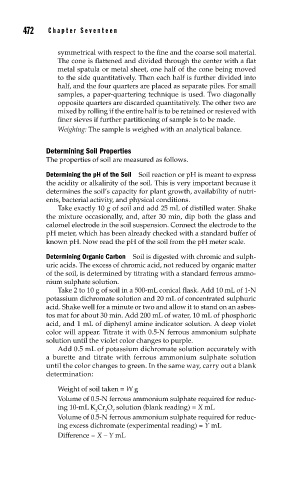Page 500 - Biosystems Engineering
P. 500
472 Cha pte r Se v e ntee n
symmetrical with respect to the fine and the coarse soil material.
The cone is flattened and divided through the center with a fl at
metal spatula or metal sheet, one half of the cone being moved
to the side quantitatively. Then each half is further divided into
half, and the four quarters are placed as separate piles. For small
samples, a paper-quartering technique is used. Two diagonally
opposite quarters are discarded quantitatively. The other two are
mixed by rolling if the entire half is to be retained or resieved with
finer sieves if further partitioning of sample is to be made.
Weighing: The sample is weighed with an analytical balance.
Determining Soil Properties
The properties of soil are measured as follows.
Determining the pH of the Soil Soil reaction or pH is meant to express
the acidity or alkalinity of the soil. This is very important because it
determines the soil’s capacity for plant growth, availability of nutri-
ents, bacterial activity, and physical conditions.
Take exactly 10 g of soil and add 25 mL of distilled water. Shake
the mixture occasionally, and, after 30 min, dip both the glass and
calomel electrode in the soil suspension. Connect the electrode to the
pH meter, which has been already checked with a standard buffer of
known pH. Now read the pH of the soil from the pH meter scale.
Determining Organic Carbon Soil is digested with chromic and sulph-
uric acids. The excess of chromic acid, not reduced by organic matter
of the soil, is determined by titrating with a standard ferrous ammo-
nium sulphate solution.
Take 2 to 10 g of soil in a 500-mL conical flask. Add 10 mL of 1-N
potassium dichromate solution and 20 mL of concentrated sulphuric
acid. Shake well for a minute or two and allow it to stand on an asbes-
tos mat for about 30 min. Add 200 mL of water, 10 mL of phosphoric
acid, and 1 mL of diphenyl amine indicator solution. A deep violet
color will appear. Titrate it with 0.5-N ferrous ammonium sulphate
solution until the violet color changes to purple.
Add 0.5 mL of potassium dichromate solution accurately with
a burette and titrate with ferrous ammonium sulphate solution
until the color changes to green. In the same way, carry out a blank
determination:
Weight of soil taken = W g
Volume of 0.5-N ferrous ammonium sulphate required for reduc-
ing 10-mL K Cr O solution (blank reading) = X mL
2 2 7
Volume of 0.5-N ferrous ammonium sulphate required for reduc-
ing excess dichromate (experimental reading) = Y mL
Difference = X – Y mL

